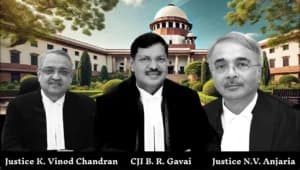As of now, 81,712 cases remain pending in the Supreme Court of India, leading to significant delays in justice delivery. This huge backlog not only prolongs the wait for citizens seeking legal resolution but also hampers the timely hearing of crucial constitutional matters. The primary challenge arises from the constant need to balance regular case hearings with constitutionally significant ones.
Two major obstacles prevent the formation of a long-term strategy to tackle pendency:
- A lack of continuity in policies due to frequently changing Chief Justices
- Dependence on government support for certain reforms, like appointing more judges or establishing additional courts
Yet, this does not mean the Supreme Court is helpless. There are several important steps the Court itself can take to bring down the backlog.
“The Court is not powerless. It holds the authority to adopt internal reforms that can significantly reduce case pendency.”
Read Also:- The Constitution Must Be Practised, Not Just Preache, Or It Will Die: Justice S. Muralidhar
1. Rethink ‘Miscellaneous Days’
Currently, Mondays and Fridays are designated as "Miscellaneous Days", during which the Court does not hear or decide final cases. Instead, it spends time selecting which cases are worth admitting for full hearings. Between 2015 and 2019, an analysis showed that out of every 100 admission-stage hearings, the Court admitted only 13 cases for hearing on merits.
In 2023, out of 191 working days, 89 days were marked as Miscellaneous Days—meaning almost 47% of the Court’s time was spent deciding which 13% of cases to accept. This process often involved extremely short hearings, with some lasting just 93 seconds.
“Nearly half of the Court’s working time goes into selecting future cases, not resolving the ones already admitted.”
A better approach would be for judges to make decisions on admission based on written submissions, reviewed privately in chambers. If there’s uncertainty, a hearing could then be scheduled. This is already the practice in Review Petitions and can be extended to regular admission matters. Implementing this requires an amendment to the Supreme Court Rules, something the Court has the power to do—subject only to the President of India's approval.
This change would free up valuable time and allow the Court to focus on cases it has already agreed to hear—a crucial step towards reducing pendency.
2. Proactively Group Similar Cases
Currently, grouping related cases depends heavily on lawyers requesting that their cases be "tagged" with similar ones. But lawyers might not be aware of all related cases, and some may even attempt to manipulate tagging to appear before preferred judges.
Instead, the Court should take initiative in:
- Identifying and grouping similar cases
- Listing these cases before the same bench on the same day
For example, all land acquisition cases from one revenue district could be heard together. Similarly, pension claims involving the same employer could be grouped. This strategy would bring about:
- Consistency in judgments
- Specialised benches hearing specific matters
- Minimised manipulation by legal counsels
“Grouping similar matters ensures clarity, fairness, and faster judgments by subject-matter experts.”
3. Shift to a True E-Filing System
While the Supreme Court already has an e-filing system, it largely involves uploading PDFs. Ironically, these are often not machine-readable and are printed out again by the Court, defeating the purpose.
A true digital system should include:
- Online forms for direct entry of case details
- Structured data on revenue districts, FIR numbers, disputed amounts, etc.
This would eliminate clerical errors and formatting issues (like incorrect fonts or page numbers), and allow for automated data sorting and case categorisation—saving enormous time.
“The present e-filing system is more paper-in-digital-form. A modern solution must be smarter, faster, and data-driven.”
Read Also:- Patna High Court Dismisses Plea Against Site Change for Panchayat Sarkar Bhawan in Darbhanga, Citing No Legal Right Was
4. Use Data to Target Simple Cases
Artificial Intelligence (AI) has been discussed for judicial use, but its effectiveness depends on high-quality data—which is currently lacking.
With better data, the Court could:
- Identify small or simple cases (like minor tax or criminal matters with sentences under three years)
- Prioritise appeals where the accused has served over 50% of the sentence
While the new case categorisation system is a step forward, more comprehensive and systematic data collection is required for such strategies to be fully realised.
“AI needs data. The Court must first gather reliable, structured case information to unlock real reform.”
5. Apprehensions About Fewer Oral Hearings
One concern is that reducing oral hearings may harm litigants or reduce lawyers’ appearances and income. When oral arguments for Review Petitions were removed in the 1970s, the decision was challenged by lawyers.
However, in P.N. Eswara Iyer v. Registrar, Supreme Court of India, a Constitution Bench upheld the change, ruling it did not violate any legal rights. It was seen as a pragmatic solution to an overwhelming workload. The Court noted that countries like the United States, United Kingdom, and recently Australia, had similarly eliminated mandatory oral hearings for admission-stage cases.
“The absence of oral hearings does not violate rights—it’s a necessity in managing the Court’s burden.”
— Supreme Court in Eswara Iyer case
6. Establish a Permanent Reform Body
Finally, the Supreme Court should create a dedicated institution responsible for continuously studying and implementing reforms to reduce pendency. This body should:
- Combine expertise in Supreme Court procedures and data analysis
- Conduct empirical studies
- Engage with stakeholders
- Publish transparent strategies
Importantly, this body should help build long-term strategies agreed upon by successive Chief Justices. Such continuity is essential to addressing the backlog effectively and sustainably.
“A standing reform body will provide the consistency and expertise needed to defeat judicial pendency in the long run.”
By adopting these six strategies—reforming case admission processes, grouping similar cases, digitising efficiently, using data smartly, addressing concerns on oral hearings, and establishing a reform body—the Supreme Court can take meaningful, independent action to tackle its case backlog.
The power to reduce pendency is in the Court’s own hands.










